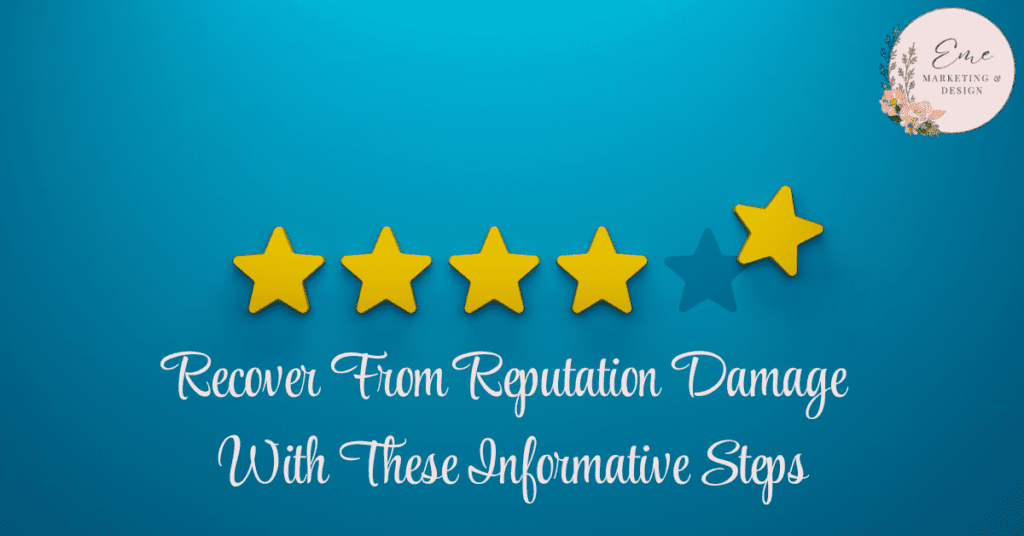
In today’s interconnected digital world, a company’s reputation can make or break its success. Managing a tarnished reputation requires deliberate and strategic efforts, whether due to a public relations crisis, a product failure or negative press. Reputation repair isn’t just about damage control; it’s about rebuilding trust and restoring confidence in your brand. In this blog post, we’ll explore how organizations can recover from a negative public perception.
Understanding the Impact of Reputation Damage
Before discussing the steps for reputation repair, it’s crucial to grasp the significance of a damaged reputation. Negative publicity can result in customer loss, reduced sales, investor distrust and even legal repercussions. Moreover, in the age of social media, information spreads rapidly, amplifying the effects of negative publicity.
Step 1: Assess the Situation
Assessing the situation is the cornerstone of any effective reputation repair strategy. This step involves a comprehensive examination of the factors contributing to the negative public perception, whether it stems from a product failure, a public relations crisis, or other issues. Data from diverse sources, including social media mentions, traditional media coverage, customer feedback and internal reports, is essential. By conducting a thorough analysis, organizations can gain valuable insights into the root causes of reputation damage, understand its impact on key stakeholders, and assess the extent of the damage inflicted. This information is the foundation for developing a targeted and strategic approach to reputation repair, guiding subsequent actions and communication efforts.
Furthermore, assessing the situation requires a keen understanding of the broader context surrounding the crisis or issue at hand. This includes evaluating the competitive landscape, regulatory environment and prevailing market trends. Organizations can identify opportunities and challenges by contextualizing the situation within these larger frameworks, anticipating stakeholder reactions and developing proactive strategies to mitigate reputational damage. Additionally, assessing the situation allows organizations to determine the urgency and resources needed to address the issue effectively. This proactive approach enables organizations to navigate the complexities of reputation repair with clarity and purpose, laying the groundwork for a successful recovery process.
Step 2: Apologize and Take Responsibility
Once the situation has been assessed, the next crucial step in reputation repair is issuing a sincere apology and taking full responsibility for the actions or circumstances that led to the negative perception. An apology is a powerful acknowledgment of wrongdoing, demonstrating humility, empathy and a genuine desire to make amends. Organizations must convey their apology through transparent and authentic communication channels such as public statements, press releases or direct outreach to affected stakeholders. Organizations can rebuild trust and credibility with their audiences by expressing remorse and accepting accountability.
Taking responsibility goes hand in hand with issuing an apology. This involves acknowledging the impact of the actions or decisions that contributed to the reputation damage and committing to rectifying the situation. It’s essential for organizations to refrain from making excuses or deflecting blame, as doing so can undermine the sincerity of their apology. Instead, leaders should demonstrate integrity and leadership by accepting accountability for any mistakes or oversights and outlining concrete steps to address the underlying issues. By taking ownership of the situation and demonstrating a commitment to positive change, organizations can lay the groundwork for rebuilding trust and regaining the confidence of their stakeholders.
Step 3: Communicate Effectively
Effective communication is paramount in reputation repair, serving as the bridge between organizations and their stakeholders during times of crisis. Transparency, clarity and consistency are fundamental principles that guide communication efforts. Organizations must keep stakeholders informed about the steps to address the situation and prevent similar incidents in the future. This involves developing a comprehensive communication strategy that outlines the key messages, target audiences and channels of communication. Whether through social media updates, press releases or direct outreach to customers and partners, organizations must ensure their messaging is timely, accurate and empathetic.
In addition to outward-facing communication, internal communication is crucial in reputation repair. Employees are often the frontline ambassadors of a brand, and their morale and confidence can significantly impact how the organization is perceived externally. Leaders must foster an open and transparent internal communication culture, keeping employees informed about the situation and soliciting their input and feedback. By empowering employees with the information they need to understand the challenges and contribute to the solutions, organizations can cultivate a sense of solidarity and shared purpose, strengthening their ability to weather the storm of a damaged reputation.
Step 4: Implement Corrective Actions
After issuing apologies and communicating effectively, the next critical step in reputation repair is implementing concrete corrective actions. This involves addressing the root causes of the issues that led to the negative public perception and making tangible improvements to prevent similar incidents. Whether improving product quality, revising internal policies and procedures or enhancing employee training, organizations must demonstrate a commitment to positive change through their actions. These corrective actions should be guided by insights gathered during the assessment phase and aligned with the organization’s values and objectives.
Moreover, implementing corrective actions requires a collaborative and cross-functional approach. Leaders must mobilize resources, engage relevant stakeholders, and establish precise accountability mechanisms to ensure the successful execution of the proposed solutions. It’s essential to prioritize actions based on their potential impact and feasibility, focusing on initiatives that yield the most significant benefit regarding reputation repair and long-term sustainability. By proactively addressing underlying issues, organizations can rebuild trust and credibility with their stakeholders, laying the groundwork for a more resilient and reputable brand.
Step 5: Monitor and Respond to Feedback
In the aftermath of a reputation-damaging event, monitoring and responding to feedback from stakeholders is essential for gauging the effectiveness of reputation repair efforts. This step involves actively listening to the concerns, opinions and sentiments expressed by customers, employees, investors and other relevant parties. Monitoring can take various forms, including social media listening tools, customer surveys, focus groups and direct communication channels. By systematically gathering feedback from diverse sources, organizations can gain valuable insights into their stakeholders’ evolving perceptions and expectations.
Equally important is the timely and strategic response to feedback received. Organizations must demonstrate responsiveness and attentiveness to address concerns, answer questions, and alleviate doubts or uncertainties. This requires establishing clear communication channels and designated contact points to handle inquiries and feedback effectively. By acknowledging and addressing stakeholder feedback promptly and transparently, organizations can foster trust, strengthen relationships, and demonstrate their commitment to listening and learning from past mistakes.
Step 6: Build Positive Associations
Building positive associations is a proactive step in reputation repair that involves highlighting the strengths, values and positive attributes of the organization. This can be achieved through targeted marketing campaigns, community engagement initiatives and corporate social responsibility (CSR) programs. By showcasing the positive impact of their products or services, organizations can shift the focus away from past adverse incidents and towards their contributions to society. Moreover, engaging with customers, employees and other stakeholders in meaningful ways fosters a sense of connection and loyalty, further bolstering the organization’s reputation.
Additionally, organizations can leverage storytelling to humanize their brand and create emotional connections with their audience. Sharing stories of resilience, innovation and community involvement helps to build trust and credibility by demonstrating the organization’s commitment to making a positive difference in the world. Furthermore, aligning with causes and issues that resonate with their target audience can help organizations build goodwill and differentiate themselves from competitors. By consistently reinforcing positive associations through their actions and communications, organizations can gradually rebuild their reputation and earn back the trust and confidence of their stakeholders.
Step 7: Seek External Support
In some cases, seeking external support from reputation management experts or public relations (PR) agencies can be instrumental in navigating the complexities of reputation repair. These professionals bring specialized expertise, experience, and resources, offering strategic guidance and tactical support to help organizations effectively address reputation challenges. Reputation management experts can conduct in-depth assessments, develop tailored strategies and provide ongoing monitoring and analysis to track progress and adjust tactics. Moreover, PR agencies can assist with crafting compelling messaging, engaging with media outlets, and managing communications during crises.
Collaborating with external partners can provide organizations fresh perspectives and innovative solutions to reputation-related issues. By leveraging the knowledge and networks of reputable professionals, organizations can expedite the recovery process and mitigate potential reputational risks more effectively. Additionally, external support can offer stakeholders an added layer of credibility and assurance, signaling the organization’s commitment to transparency and accountability in addressing reputation challenges. Ultimately, by enlisting the assistance of external experts, organizations can enhance their reputation repair efforts and position themselves for long-term success and resilience in the marketplace.
Step 8: Monitor Progress and Adjust Strategies
Monitoring progress and adjusting strategies is a crucial step in reputation repair, ensuring efforts remain aligned with evolving circumstances and stakeholder perceptions. Organizations should establish key performance indicators (KPIs) to track the effectiveness of their reputation repair initiatives, such as changes in brand sentiment, customer satisfaction levels, and media coverage. Regularly evaluating these metrics allows organizations to gauge their actions’ impact and identify areas for improvement. Moreover, it’s essential to remain vigilant and responsive to changes in the external environment, including shifts in market dynamics, emerging trends, and competitive landscape.
Flexibility and adaptability are essential qualities in reputation repair, as organizations must be prepared to pivot their strategies in response to new developments or feedback from stakeholders. This may involve refining messaging, reallocating resources or revising action plans to address emerging challenges or opportunities. By maintaining a proactive and agile approach to reputation management, organizations can stay ahead of the curve and effectively navigate the complexities of rebuilding trust and credibility with their stakeholders. Additionally, ongoing monitoring and adjustment ensure that reputation repair efforts remain relevant and impactful, paving the way for sustained recovery and long-term success.
Final Thoughts
Recovering from a negative public perception is challenging but achievable. Organizations can rebuild trust and restore confidence in their brand by taking proactive steps to address the underlying issues, communicate effectively, and demonstrate a commitment to positive change. Remember, reputation repair is not just about mitigating damage; it’s about laying the foundation for long-term success and sustainability.




